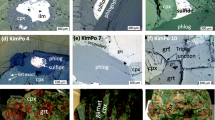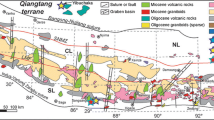Abstract
Bulk compositions and mineral analyses for forty-one, large, garnet- and spinel-facies peridotite xenoliths from the Udachnaya kimberlite in the central Siberian platform have many similarities to those of well-studied peridotites from the Kaapvaal craton in southern Africa. Coarse Mg-rich lherzolites and harzburgites with equilibration temperatures below 1000 °C are abundant and are believed to form the principal rock type in the Siberian lithosphere. The low-temperature Udachnaya peridotites have an average mg number [Mg/(Mg+Fe)] of 92.6 with a wide dispersion in modal enstatite, ranging to over 40 wt%. High-temperature peridotites are relatively richer in Fe and Ti and are commonly deformed, with porphyroclastic or mosaic-porphyroclastic textures, some of the latter having fluidized enstatite. The Udachnaya peridotites have experienced late-stage metasomatism before, during and after eruption. Garnets and pyroxenes in many of the high-temperature rocks are zoned, probably by reaction with melt prior to eruption. Virtually all the peridotites contain secondary diopside, inhomogeneous on a micron scale, that mantles primary orthopyroxene. It is believed to have crystallized along with lesser amounts of intergranular calcite and monticellite during eruption. Bulk analyses for total Fe in many specimens are higher than whole-rock Fe calculated from the electron probe analyses and the modes. The magnitude of the difference between the two measurements of total Fe correlates with loss-on-ignition, suggesting that Fe has been introduced during serpentinization following eruption. These late metasomatic processes have thus affected some major as well minor and trace element compositions. The similarities in bulk composition of peridotites from Udachnaya and the Kaapvaal are evidence of a common origin. Low-temperature cratonic peridotites differ from oceanic peridotites in having higher mg numbers (>92) and in having relatively high but wide-ranging modal enstatite (Mg/Si = 1.06–1.49 weight fraction). The Udachnaya low-temperature peridotites have an inverse correlation between FeO (calculated from the probe analyses and modes) and SiO2. This correlation is also present in the Kaapvaal data but is complicated by a greater range in fertility that produces a positive variation of Fe with Si. A negative trend for Fe/Si can be seen within a portion of the Kaapvaal data, that for low-Ca harzburgites, in which the variation in fertility is restricted. The negative trends for Fe/Si can be interpreted as a consequence of either segregation of olivine and orthopyroxene by metamorphic differentiation or partial sorting during cumulate formation.
Similar content being viewed by others
Author information
Authors and Affiliations
Additional information
Received: 18 June 1996 / Accepted: 11 February 1997
Rights and permissions
About this article
Cite this article
Boyd, F., Pokhilenko, N., Pearson, D. et al. Composition of the Siberian cratonic mantle: evidence from Udachnaya peridotite xenoliths. Contrib Mineral Petrol 128, 228–246 (1997). https://doi.org/10.1007/s004100050305
Issue Date:
DOI: https://doi.org/10.1007/s004100050305




